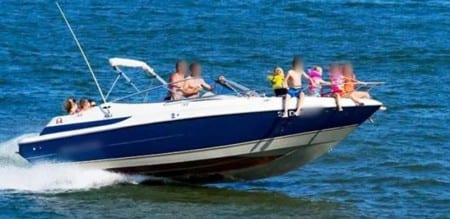 By Bob Currie, Recreational Boating Safety Specialist
By Bob Currie, Recreational Boating Safety Specialist
U. S. Coast Guard Auxiliary Base Galveston Flotilla
This column addresses another category of accident statistics from the 2020 Boating Accident Statistics. Although it is not one of the big boating accident statistics categories, it involves illegal practices that we see all the time on recreational boats: Improper Loading of Passengers and Gear. In this category for 2020 there were 140 reported accidents that caused 56 deaths and 67 injuries.
The Base Galveston Flotilla of the US Coast Guard Auxiliary operates out of the US Coast Guard base on Galveston Island. They aid the Coast Guard by providing maritime observation patrols in Galveston Bay; by providing recreational boating vessel safety checks; and by working alongside Coast Guard members in maritime accident investigation, small boat training, providing a safety zone, Aids to Navigation verification, cooking in base and station galleys and aboard cutters; and as drone pilots on the Coast Guard Drone Team.
There are three subcategories to this category:
1. Improper Loading
2. Overloading
3. People on Gunwale, Bow or Transom
Overloading is the subcategory with the highest number of accidents and deaths, but people on the gunwale, bow or transom has the highest number of injuries.
Improper Loading
Improper loading is about balancing the load in your boat and includes both gear and passengers. The risks of improper loading are capsizing the boat and swamping the boat. In either case people are going to end up in the water, and in cases where the boat is underway there is a high risk of passengers being run over by the boat with subsequent contact with a rotating propeller. I don’t think I need to post a picture of that. The most likely contact with the propeller is with the head, and those who survive are often severely maimed for life. Before leaving the dock you should ensure that gear is properly distributed for weight and secured, and that all passengers have an assigned seat and are actually in their seats before you get underway.

Overloading
We see overloading a lot. Everyone likes to take the entire family out for a boat ride. The overloaded boat in the picture, while dangerously overloaded, isn’t as likely to swamp or capsize in those calm waters as it would be anywhere in Galveston Bay, where even on a calm day that boat wouldn’t get very far. Add in the fact that no one has a life jacket on and you really have a recipe for disaster.  The danger here is that the boat will swamp and capsize, and one thing we always notice is that overloaded boats rarely have passengers who are wearing life jackets. Lack of common sense is across the board. Rather than overload your boat, pay attention to the Maximum Capacities sticker on your boat. It gives you the maximum number of persons and weight that the boat can safely carry. Use the most restrictive of the two when loading your boat. The maximum persons category tends to reference a person that weighs 150-160 pounds. I haven’t weighed that little in 50 years. If you are going to use the total weight of persons, motor and gear, you need to know how much your motor weighs. I have never come across anyone who knew that.
The danger here is that the boat will swamp and capsize, and one thing we always notice is that overloaded boats rarely have passengers who are wearing life jackets. Lack of common sense is across the board. Rather than overload your boat, pay attention to the Maximum Capacities sticker on your boat. It gives you the maximum number of persons and weight that the boat can safely carry. Use the most restrictive of the two when loading your boat. The maximum persons category tends to reference a person that weighs 150-160 pounds. I haven’t weighed that little in 50 years. If you are going to use the total weight of persons, motor and gear, you need to know how much your motor weighs. I have never come across anyone who knew that.
People on Gunwale, Bow or Transom
We see this situation all too often. If the boater in the picture hits a wave or wake hard enough, the little boy with no life jacket will be thrown overboard and drown and his body will be found 48 hours later, and the girls in the life jackets will have their heads cut off by the propeller.

Anyone with common sense can see those as probable outcomes, yet we see this situation every time we go out on patrol. Everyone must be in their assigned seats whenever you are underway, and all children younger than 13 must have a life jacket on when underway unless they are inside an enclosed cabin. If you see someone operating their boat like this, you can be pretty sure they have no knowledge of the Rules of the Road either. Avoid them like the plague.
Summary
Although the Recreational Boating Statistics category, Improper Loading of Passengers and Gear, is a relatively small category as far as the 2020 statistics go, it includes 140 accidents with an 87 percent chance of death (40%) or injury (47%). The key to getting everyone in the boat home safely (other than wearing a life jacket) is to ensure that the boat is balanced in regard to the placement of gear and passengers, ensure that the boat is not overloaded, and ensure that all passengers are seated in a proper seat before getting underway and do not let anyone sit on the gunwales, bow, or transom.
For more information on boating safety, please visit the Official Website of the U.S. Coast Guard’s Boating Safety Division at www.uscgboating.org. Questions about the US Coast Guard Auxiliary or our free Vessel Safety Check program may be directed to me at [email protected]. I am available to perform free Vessel Safety Checks, and I will come to your location to perform them. SAFE BOATING!
[July-13-2021]

 Posted in
Posted in 
























